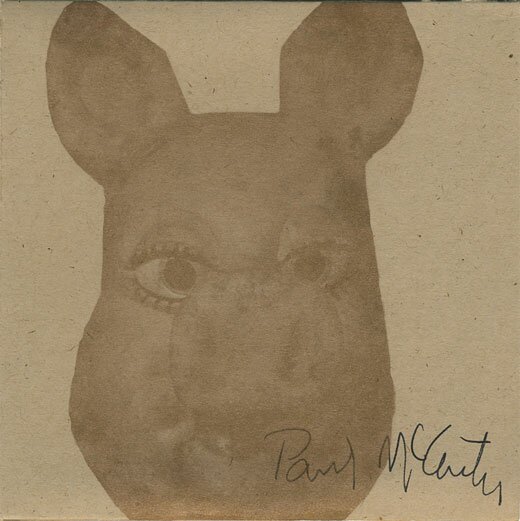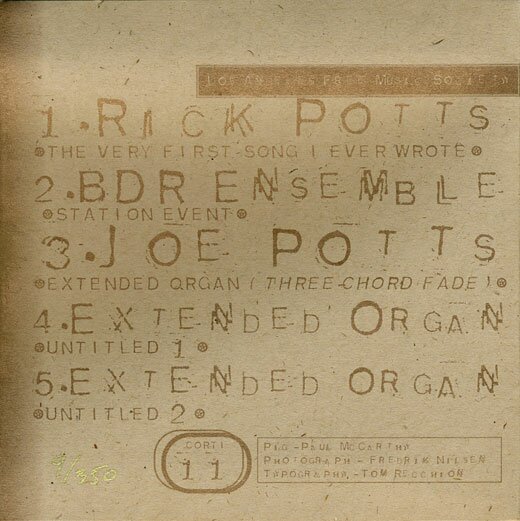image & sound
Archived Posts from this Category
Archived Posts from this Category
Posted by ben on 01 Jun 2009 | Tagged as: architecture, image & sound, music, responses/reviews, sound art
In a post at my new blog on Glasstire, I discuss the relationship between Rudolf de Crignis (currently showing at Lawrence Markey) and La Monte Young, as a way of exploring uses of the term minimalist. This comparison could be extended to some of the other minimalist composers, such as Phill Niblock, who activate architectural space through dense layers of sound at high volume.
But it’s worth noting that while the perceived variation induced by the Dream House’s standing waves calls attention to the physical space, the effect of these relatively small de Crignis paintings is to absorb the viewer in an alternate, purely visual space. It is perhaps the same effect Francis Bacon aims at when : “You would love to be able in a portrait to make a Sahara of the appearance — to make it so like, yet seeming to have the distances of the Sahara.” So while de Crignis’ paintings play with visual perception in a way that is analogous to Young’s or Niblock’s effect on the ear, they are perhaps more disorienting because they absorb the viewer in layers of paint, supplanting for a moment the physical space around them. It is interesting, though, that de Crignis is sometimes compared to James Turrell, an artist who does work with light sources and architecture in a way that is more obviously akin to Marian Zazeela’s light installation in the Dream House.
Posted by aaron on 20 Jan 2009 | Tagged as: celebrations, image & sound, music, politics
Performed by Los Dorados del Norte. Music & lyrics by… ?
Posted by ben on 07 Nov 2008 | Tagged as: image & sound, music, vs.
It can be performed by any kind and number of instruments or voices. Only one instrument must play ad libitum the series with the last three or four notes (right) at random, but returning always to A flat. All other instruments and voices can be well tuned or fluctuate within a very small interval above and below the notes frequency of the instrument playing ad libitum: they can’t play more than five notes of the series for each performance.
— Roberto Donnini, instructions for Tunedless, 1977
The first drafter draws a not straight vertical line as long as possible. The second drafter draws a line next to the first one, trying to copy it. The third drafter does the same, as do as many drafters as possible. Then the first drafter, followed by the others, copies the last line drawn until both ends of the wall are reached.
— Sol LeWitt, instructions for Wall Drawing #123: Copied Lines, 1972
[Cross-posted at Scattered Work]
Posted by justin on 05 Nov 2008 | Tagged as: adventure day, announcements, art paparazzi, image & sound, in yo face, vs.
Posted by michelle on 30 Oct 2008 | Tagged as: image & sound, video/film
Posted by ben on 11 Aug 2008 | Tagged as: image & sound, music, performance art, sound art
I’m honored to be able to offer a recording of Crevice’s Infinity Asylum performance on this blog. This is a truly beautiful recording by one of the few groups in Texas to successfully bridge the music and art worlds. Infinity Asylum was part of an installation / performance at the Friedrich Building, a 500,000 square foot space on the east side of San Antonio, originally built to produce air conditioners. Tucked away in little nooks and crannies of the building were a number of installations (artists included: Dwayne Bohuslav, Christopher Biasiolli, Nate Cassie, Rae Culbert, and Jack Robbins). As visitors explored the space, Crevice played this “peaceful, hypnotic, cyclical music” (to quote from the original press release), which fell in and out of earshot. Many of the vocals you hear in the recording are samples of people talking about the installations, thus folding audience reaction into the performance. It was recorded on July 11, 2003.
Performers on this recording: Jeff DeCuir (guitar, processors), Jessica Barnett DeCuir (harmonica, percussion), John Navarro (theremin, processors), Bryan Stanchak (synth, bass), Stephen Reyna (guitar/e-bow).
Posted by justin on 21 Jul 2008 | Tagged as: art + bikes, art paparazzi, image & sound, performance art, photography, renegade performances, video/film
Posted by ben on 04 Apr 2008 | Tagged as: design, image & sound, music, performance art

In another attempt to explore the intersection of music and visual art (see also), I give you a rare Los Angeles Free Music Society CD, on which Paul McCarthy plays alongside fellow artists John Duncan and Tom Recchion, photographer Fredrik Nilsen, and noise pioneer Joe Potts (of Airways). Included with an edition of The Lowest Form of Music box set, this CD includes a 30-minute organ drone by Potts, a recording of a radio “event” by the BDR Ensemble (Michael Delle Donne-Bhennet, John Duncan, and Tom Recchion), and some indescribable weirdness from Extended Organ (Joe Potts, Fredrik Nilsen, Paul McCarthy, and Tom Recchion). I’m including a few notes on the recordings below.
“3 CHANNEL CHORDS” was produced in an attempt to create an undulating mass of sound which seemed at first to be static drone while actually being a complex constantly mutating entity. The music was recorded in these separate takes on three tracks. Each track has sixteen channels of “CHOPPED OPTIGAN” run through a stereo mixer with the slide pots arranged to form a sine-wave pattern. Overt the course of thirty-plus minutes the sliders are constantly adjusted so that the sine pattern ripples across the mixer and then returns to the starting position. This formula is repeated on three separate channels, and then mixed down to stereo. I performed it and Rick Potts engineered it in his studio/living room. This recording marks the debut of the CHOPPED OPTIGAN.
— Joe Potts

BDR Ensemble: Michael Delle Donne-Bhennet / John Duncan / Tom Recchion * KPFK 90.7 FM-Los Angeles * Sponsored by Close Radio * December 1, 1977 * Duration 80 Minutes
Station Event was intended to use as a medium of communication rather than one of broadcast. It was performed live over Close Radio from two separate rooms: Delle Donne Bhennet (woodwinds and percussion), Recchion (invented instruments, piano and available materials) performed in KPFK’s Studio A. Paul McCarthy joined them toward the end of the work. From the control room, Duncan asked for and monitored phoned-in responses to what the ensemble was doing. Telephone calls and music from Studio A were mixed at the discretion of Steve Tyler, night engineer at KPFK. The two rooms were sound-separated, Tyler alone was able to hear the complete broadcast at its source.
— Tom Recchion

Posted by ben on 22 Feb 2008 | Tagged as: image & sound
I’m going to start spending some time here discussing the mutual influence between music and visual art. Despite the supposed openness of the visual art world, these connections are still overlooked by too many of us. I plan to flesh out this intersection quite a bit in the coming weeks.
In 1952 John Cage composed a controversial work that has now become canonical, although it still arouses a great deal of suspicion among those who are inclined to think that starting in the second half of the 20th century, art became one big put-on. This piece, titled 4′33″, consists of four minutes and thirty three seconds of silence (here’s a ). Unfortunately, many people associate John Cage so closely with 4′33″ that they don’t know of any of his other compositions. I think some of these people might be inclined to take it more seriously if they were aware that this piece is part of a long career of very sincere exploration. In many ways, this composition is much more accessible than a lot of more “appealing” art, in the sense that it doesn’t hide anything — the idea of the composition is right there on the surface.
But there is a bit of history to the work that belies its apparent simplicity. The idea came about as a result of Cage’s Zen Buddhist practice (he was an original board member of the Zen Mountain Monastery near Woodstock, New York). Cage’s first public discussion of the work comes in his 1948 book “A Composer’s Confessions”, where he says that he would like to “compose a piece of uninterrupted silence and sell it to the Muzak Co. It will be 4 [and a half] minutes long — these being the standard lengths of ‘canned’ music, and its title will be ‘Silent Prayer’. It will open with a single idea which I will attempt to make as seductive as the color and shape or fragrance of a flower. The ending will approach imperceptibly.” But it wasn’t until four years later that he actually realized 4′33″. What happened in those four years?

Robert Rauschenberg sits in front of his “White Paintings”
According to Cage, it was seeing Robert Rauschenberg’s “White Paintings” that finally convinced him he had to move forward with 4′33″. These paintings consist of a uniform layer of white paint on canvases. In the words of Cage, these paintings “were airports for shadows and for dust, but you could also say that they were mirrors of the air.” Similarly, Cage’s 4′33″ is an airport for sound; a hub of perception. He realized that the space of a gallery, or a performance hall, is a cathedral for perception. Why not use this space to create an opening for heightened perception of life, of the present moment in general? Rauschenberg and Cage turn the compartmentalization of these art spaces against themselves by making the invisible background noise of life the focus of our attention.